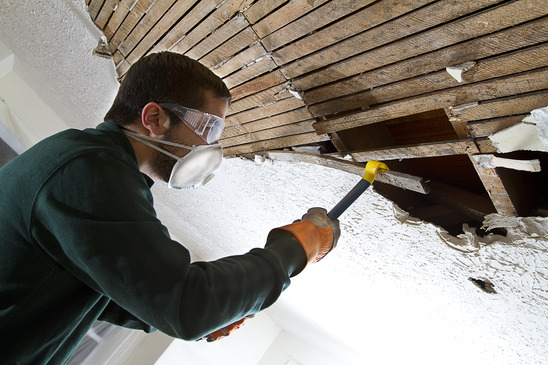
Restoring Ceilings After Water Damage
Ceiling stains range in colour from light copper to dark brown, and the paint will often bubble up. If there are moisture bubbles, chances are that the paint will continue to chip and crack, if it has not done so already. Acting quickly will reduce the amount of work and damage, so get started now with this simple guide.
NOTE – Expediency is everything!
It is important to ensure that the non-cosmetic damage has been dealt with accordingly. The risk of mould and mildew after a flood is much higher than normal, so make sure to fix all other issues before restoring the look of the ceiling. Restoring the look of the ceiling could help you notice more serious, and dangerous, issues after a flood or other water damage has occurred.
What you will need to get the job done:
- A wire brush. This will help you scrub away old paint that has degraded from excessive water exposure. This paint will not be salvagable.
- A household cleaner. It is important to aim for the proper potency when selecting your cleaner; something too strong could corrode through your ceiling surface. A mild detergent, dishwashing liquid, or all-purpose cleaner will suffice since we are using this exclusively to offset the chances of mold growth.
- Primer. Primer is important in any painting endeavour. Applying a coat without proper primer is asking for trouble with even coatings, paint adhesion, and colour retention. Primer is even more important when dealing with water-damaged ceilings, so choose wisely and don’t skimp on quality here!
- Shellac. Shellac will help your primer lock in place, so don’t overlook this essential item. After water damaged sets in, your ceiling will need all the help it can get!
Paint. You can colour-match to your old ceiling, or use this restoration effort as an opportunity to coat your home with a new shade.
1) Remove old paint.
The first step is to remove that crackled, bubbled paint that has loosened up from the water damage. Use the wire brush to scrape off loose paint. While you are making your way through this process, it is also a good idea to use the household cleaner in between scrapings. This will help lessen the chance of mold later. One this is done, wait for the surface to be completely dry before proceeding to the next step.
2) Shellac the affected area.
This step is very important, and is often overlooked. Before you put on the primer, add one coat of shellac. Allow it to dry completely, then add another coat. Be consistent with your brush type and the direction of application, as this will make your ceiling look as good as new. Shellac is especially important to use in areas that have been damaged because of water, and will be an essential part of the restoration process.
3) Time to prime.
Make sure you have purchased a reliable, high quality primer for this job! The primer will greatly aid in restoring your ceiling, making it look new, and buying a cheaper, low quality primer will show less results. Apply it as your normally would a primer and, again, allow for complete drying before continuing. Don’t rush this drying process; a little patient now will save you a lot of problems later.
4) Paint, paint, paint!
Now that you have gotten rid of the old paint and applied shellac and primer, you have gotten to the fun part – painting! Make sure that the previous coats have fully and completely dried before continuing to this step. Apply an even coat of the same paint colour as the rest of the ceiling. Apply more than one coat if necessary, still making sure to let the paint fully dry in between applications. If the ceiling has not been painted in a very long time, the restored area might seem lighter than the rest of the ceiling. This will gradually fade over time, and the newly painted area will eventually match the rest of the paint.

